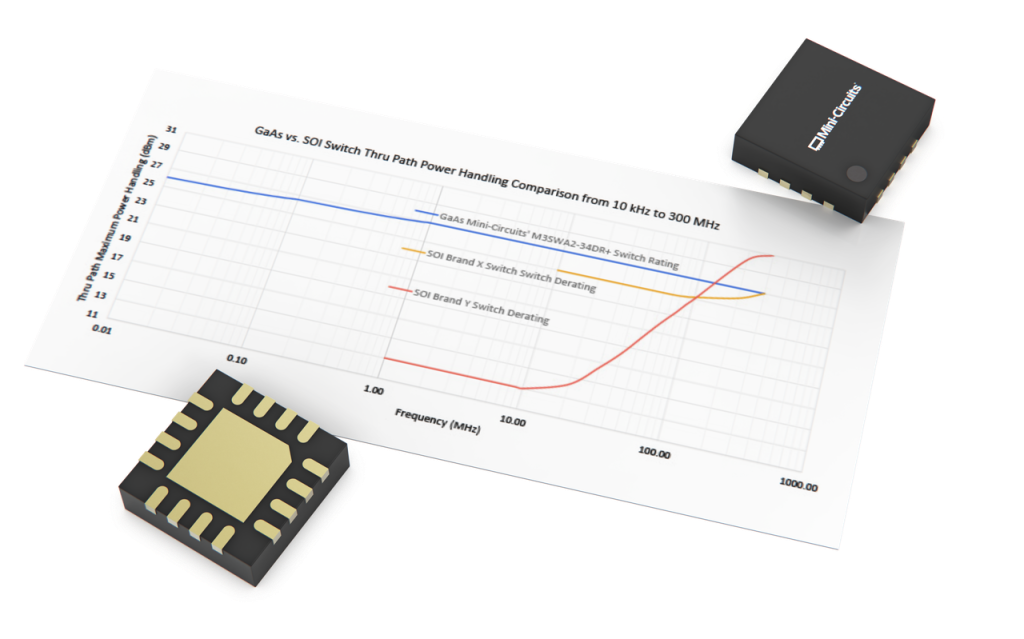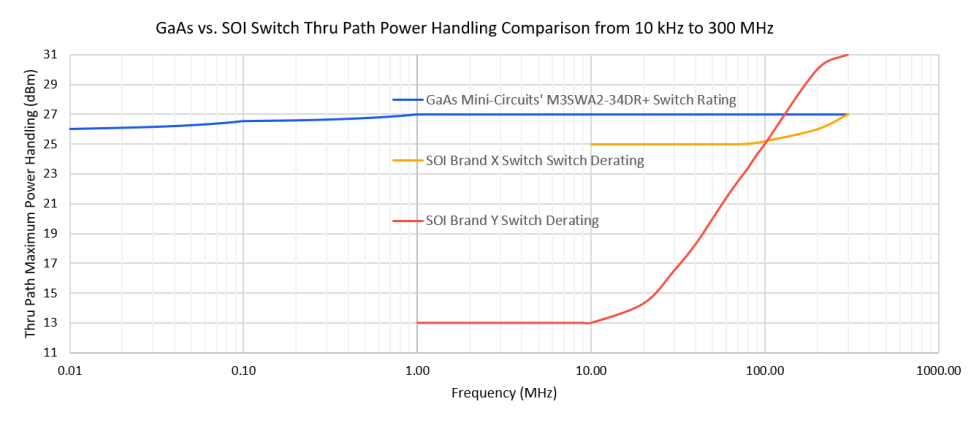Fast-Switching GaAs Switches Are a High-Performance, Low-Cost Alternative to SOI

A mistaken belief has arisen in recent years that SOI has somehow taken over as the prevailing technology for fast RF switch applications, but not so fast! Mini-Circuits’ recent introduction of the M3SWA2-63DRC+ and the M3SWA2-34DR+ ultrafast, absorptive RF switches has given cause for designers to reconsider their switch choices. Designers are discovering that it is no longer necessary to bear the expense of an SOI switch just to get the speed they need.
In this application note, we perform a comprehensive, side-by-side, parametric comparison of the Mini-Circuits’ wideband GaAs MMIC M3SWA2-34DR+ switch to two SOI competitive offerings. This comparison leads us to the conclusion that there is no reason to take your foot off the GaAs.
GaAs vs. SOI RF Switch Parametric Comparison
Frequency Coverage
At a glance, an RF switch appears to be a simple element, but there are a multitude of specifications that comprise its performance over frequency and time. Table 1 draws a comparison of more than a dozen such specification parameters for the Mini-Circuits M3SWA2-34DR+ wideband GaAs MMIC Switch and two wideband SOI MMIC switches. The lighter color coding suggests higher performance for that particular parameter, and the concept in Table 1 is to highlight performance from darker to lighter shading on a good-better-best basis. One of the first parameters to examine is frequency coverage. One benefit of GaAs RF switches is their ability to operate at very low frequencies, essentially down
to DC. For decades, GaAs switches were the device of choice for high-frequency operation as well, and still are in many applications. To achieve very high-frequency operation (tens of GHz), SOI devices are constructed with very tiny geometry transistors to reduce parasitic capacitance. Most often this reduction in geometry leads to limited low-frequency operation. Brand Y in Table 1 exhibits such a limitation, with operation specified no lower than 100 MHz. The Brand X switch, however, boasts operation down to DC. We’ll find out what tradeoffs in performance have been made in the Brand X switch to achieve low-frequency operation as we examine switching time and power handling.
On the high-frequency end of the spectrum, the Mini-Circuits’ M3SWA2-34DR+ GaAs MMIC switch operates to 30 GHz, while the SOI switches used in the comparison operate to 67 GHz for Brand X, and 45 GHz for Brand Y. GaAs technology to date has yielded equally as high a frequency switches as the SOI switches in Table 1, but in this comparison, the two SOI switches have a distinct advantage in frequency coverage.

Insertion Loss, Isolation and Linearity
To draw a direct comparison to the 30 GHz M3SWA2-34DR+ GaAs MMIC RF switch from Mini-Circuits, the insertion loss and isolation parameters for the SOI switches in Table 1 are listed at approximately 20 GHz and 30 GHz. Note that the Mini-Circuits’ GaAs MMIC is very competitive at 20 GHz (only 0.05 dB greater insertion loss than the 67 GHz Brand X), but rolls off several tenths of a dB at 30 GHz, which is its upper frequency of operation.
Isolation for the GaAs switch is just 7 to 10 dB less than for the SOI devices, at 20 and 30 GHz, respectively. Linearity is usually a key differentiator for SOI, but with an IIP3 of just 5 to 8 dB better for the Brand X and Brand Y devices, respectively, the Mini-Circuits’ GaAs switch really holds its own.
Thru Path Power Handling
One area in which the Mini-Circuits’ M3SWA2-34DR+ GaAs MMIC RF switch performs well is in maximum power handling (Pmax). Table 1 lists both in-band Pmax as well as Pmax at the low end of the frequency band (10 kHz, 1 MHz and 100 MHz). Not only is the in-band power handling of the M3SWA2-34DR+ better than Brand X and only 3 dB shy of Brand Y, but the GaAs switch significantly outperforms the others in terms of low-frequency power handling, as shown in Figure 1. The Mini-Circuits’ M3SWA2-34DR+ GaAs switch power handling is rock solid down to 10 kHz, whereas Brands X and Y derate below 300 MHz, and in the case of Brand Y, very significantly. In all fairness to Brand X, its low-frequency performance is not specified at 1 MHz or 10 kHz. The continuing reduction in SOI switch power handling with declining frequency is due to the tradeoff made in constructing the SOI switches with very tiny transistor geometries. High frequency operation is achieved but limitations on low-frequency performance are introduced, especially where power handling is concerned.

GaAs Switching Speed
Table 1 shows the on time (ton), off time (toff), rise time (trise), fall time (tfall) and settling time (ts) for the Mini-Circuits’ GaAs MMIC switch and the two SOI switches. While historically, GaAs switches exhibited a phenomenon call gate lag that tends to extend the settling time to 0.05 dB, the M3SWA2-34DR+ GaAs MMIC RF switch shows no signs of slowing down, with a settling time of 29 ns to 0.05 dB, easily beating the Brand Y SOI switch to its 0.1 dB mark. Both the M3SWA2-34DR+ RF switch and the Brand Y SOI switch exhibit lightning-fast, single-digit-ns trise and tfall performance and comparable ton and toff times. Brand X suffers from relatively slow switching times in the hundreds of ns, likely due to the tradeoff made that enables that particular SOI switch to operate to such a low frequency (essentially DC).
The Cost-Effectiveness of GaAs
While GaAs RF switches do not quite achieve some of the performance metrics of SOI switches, one area in which GaAs MMIC switches excel tremendously is in their cost-effectiveness. GaAs MMIC RF switches cost approximately 20-25% of the cost of a comparable SOI MMIC switch. Stated differently, as shown in the rightmost column of Table 1, the Brand X and Brand Y SOI MMIC switches cost 4.8 and 3.9 times more than the M3SWA2-34DR+, respectively. The reasons are that GaAs is a far more mature technology than SOI, and has lower processing costs. Additionally, since SOI is a new technology that injects new possibilities into the trade space, it commands a premium price, with most manufacturers trying to maintain elevated profit margins for the time being. With roughly five major suppliers of SOI RF switches, expect prices to stay high and relatively steady for the foreseeable future. Meanwhile, expect more GaAs MMIC switches to be introduced that continue to nip and the heels of their SOI rivals.
GaAs and Go
In this application note, we drew a detailed comparison between the Mini-Circuits’ M3SWA2-34DR+ GaAs MMIC RF switch and two SOI counterparts. Over a dozen parameters were examined to show how the M3SWA2-34DR+ GaAs switch holds its own against the SOI competition. The M3SWA2-34DR+ excels greatly by handling high power, even at low frequencies, while exhibiting lightning-quick switching speeds. Before you empty your wallet by shelling out the cost of an SOI switch, take a look at Mini-Circuits’ cost-effective GaAs alternatives.











